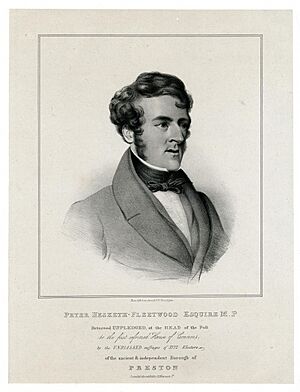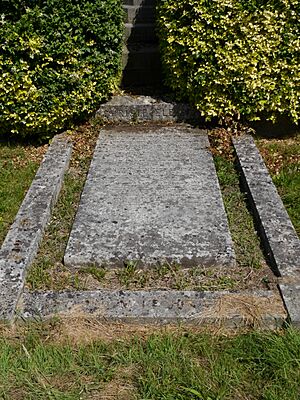Peter Hesketh-Fleetwood facts for kids
Quick facts for kids
Peter Hesketh-Fleetwood
|
|
|---|---|
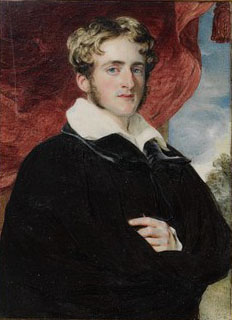
Peter Hesketh-Fleetwood painted by William Charles Ross in 1826.
|
|
| Member of Parliament for Preston |
|
| In office 10 December 1832 – 29 July 1847 Serving with
|
|
| Preceded by |
|
| Succeeded by |
|
| Personal details | |
| Born | 9 May 1801 Wennington Hall, Wennington, England |
| Died | 12 April 1866 (aged 64) Piccadilly, London, England |
| Resting place | Kensal Green Cemetery, London, England |
| Political party |
|
| Spouses |
Eliza Debonnaire Metcalfe
(m. 1826)Virginie Marie Garcia
(m. 1837) |
| Parents |
|
| Education | Trinity College, Oxford |
| Fleetwood | |
|---|---|
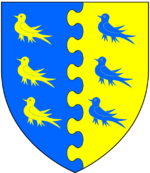
Arms of Fleetwood: Party per pale nebuly azure and or, six martlets, 2, 2 and 2 counterchanged
|
|
| Country | |
Sir Peter Hesketh-Fleetwood (1801–1866) was an English landowner and politician. He is best known for creating the town of Fleetwood in Lancashire, England. He inherited land in Lancashire and was inspired by new transport ideas of the 1800s. He wanted to build a railway to the coast and create a new holiday spot and port.
He hired architect Decimus Burton to design his new town, which he named Fleetwood. Building started in 1836. Peter Hesketh-Fleetwood helped form the Preston and Wyre Railway Company. With his money, a railway line was built between Preston and Fleetwood. It opened in 1840.
Peter Hesketh-Fleetwood married twice and had several children. Sadly, most of them passed away when they were young. His new town grew, but building it cost him a lot of money. He almost went bankrupt and had to sell most of his family's land. He moved to London and died there. His son, Louis, took over his title.
Contents
Early Life and Family History
Peter Hesketh was born in 1801 at Wennington Hall in Wennington. He was the second son of Robert and Maria Hesketh. He had two brothers, Edward and Charles, and a sister, Anna. His family was connected to the Fleetwood family, who had owned the large Rossall estate for over 200 years.
In 1819, his father inherited the Rossall estate. The family moved to Rossall Hall on the Fylde coast. When his father died in 1824, Peter inherited the estate. His older brother Edward had died earlier. By then, the family's land covered most of the Fylde area.
Education and Early Interests
Peter and his younger brother Charles went to Trinity College, Oxford. Peter enjoyed a busy social life in Oxford and London. He visited new seaside towns like St Leonards-on-Sea in Sussex. He admired the work of architect James Burton there.
Peter became good friends with Burton's son, Decimus Burton, who was also an architect. They both helped create the Athenaeum Club in London. Peter earned his Bachelor of Arts degree in 1823 and his Master of Arts degree in 1826.
Family Life and Changes
In 1826, Peter married Eliza Debonnaire Metcalfe. Her father gave them a house in Dover, but they also spent time at Rossall. Peter enjoyed managing the Rossall estate, but he found it hard to handle the money. He was a kind landlord. He also cared about local farm workers who were losing their jobs.
Peter and Debonnaire had their first child, Anna Maria, in 1827. They had three more children, but sadly, they all died when they were very young. In 1831, Peter changed his name to Hesketh-Fleetwood. He added the Fleetwood name to honor his ancestors.
Debonnaire became ill with tuberculosis and died in early 1833. Around the same time, Peter Hesketh-Fleetwood got scarlet fever. This led to another infection that caused him to lose one of his eyes. Later that year, the Rossall estate was badly flooded. After this, he spent less time at Rossall.
In 1837, Peter Hesketh-Fleetwood married Virginie Marie Garcia in Belgium. His daughter Maria died in 1838 at age 11. Around the same time, Virginie gave birth to their son, Peter Louis. In 1841, Peter Hesketh-Fleetwood also inherited Tulketh Hall in Preston.
Peter Hesketh-Fleetwood's Political Career
Peter Hesketh was chosen as the High Sheriff of Lancashire in 1830. In 1831, he was asked to run for Parliament as a Tory Party candidate for Preston. He agreed because he shared similar ideas with important politicians like Robert Peel.
Hesketh-Fleetwood was against monopolies (when one company controls everything). He also opposed slavery and the death penalty. He wanted to change the Corn Laws, which affected food prices. In the 1832 election, he was elected as a Member of Parliament for Preston. This was the first Parliament after the Reform Act, which changed voting rules. He gave his first speech in Parliament in 1834.
In 1837, Queen Victoria became queen. The next year, Peter Hesketh-Fleetwood was made a knight and given the title of Baronet Fleetwood. He remained an MP for Preston until the 1847 election. Towards the end of his time in Parliament, he was known as a Liberal MP. In 1840, he translated a book by Victor Hugo called The Last Day of a Condemned Man. He added his own thoughts against the death penalty.
Building the Town of Fleetwood
When Peter Hesketh was a student, he noticed that Lancashire didn't have many seaside resorts. He worried that working-class people in Lancashire couldn't afford holidays like wealthy people could. In the early 1800s, railways were growing fast in Britain. He was very impressed when the steam locomotive arrived in Lancashire in 1828.
As High Sheriff, he attended the opening of the Liverpool and Manchester Railway in 1830. This made him excited about bringing the railway to the coast. He wanted to make it possible for factory workers to take day trips to the seaside.
Planning the New Town
Peter Hesketh realized that day-trippers would need places to stay and things to do. He decided a new town was needed. He first thought about a spot near Thornton, but it wasn't close enough to the sea. He finally chose Rossall Point, a small area at the mouth of the River Wyre. It was a wild, empty place, but it had great views.
His friends, who owned mills, suggested he also build a new port. Shipping costs at Liverpool were rising, and there were no other good options for Manchester mill owners. They believed a new port on the Fylde coast would be very useful. Peter Hesketh soon found others were also planning railways and ports. People in Lytham, a village to the south, were already planning a Preston Port Company. Peter Hesketh quickly applied to build a port on the River Wyre.
The railway committee decided Rossall Point was the best place for the railway end point. They formed the Railway and Port Company. Back then, people thought steam trains couldn't go up hills. So, Fleetwood would be important for people traveling from London to Scotland by sea. Peter Hesketh first thought of naming his town New Liverpool or Wyreton. But after changing his own name in 1831, he decided to call it Fleetwood. He handed over the money management to his agent, Frederick Kemp.
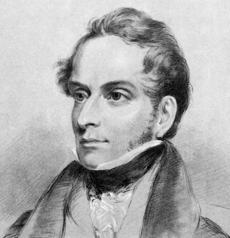
Designing and Building Fleetwood
After his wife Debonnaire died in 1833, Peter Hesketh-Fleetwood focused on his plans. He hired his old friend Decimus Burton, a successful architect. They discussed what buildings Fleetwood would need. Hesketh-Fleetwood wanted a church, docks, houses, a gas office, a school, and a hotel. Burton agreed a hotel was important for travelers going to Scotland. Since they would arrive from Euston railway station in London, Hesketh-Fleetwood named the hotel the North Euston Hotel. Burton's plans were ready by 1835.
In 1835, Peter Hesketh-Fleetwood started the Preston and Wyre Railway Company. He wanted to raise money to build the railway to Fleetwood. The estimated cost was £122,000. The company got permission to start building, with Peter Hesketh-Fleetwood promising to cover the costs. The next year, he and Burton oversaw the start of Fleetwood's first street, and the first railway tracks were laid.
Financial Troubles and Challenges
By 1838, the cost of building the town was getting out of control. The railway was also expected to cost over £300,000. The company had not sold as many shares as hoped. Frederick Kemp, his manager, was collecting money but claimed there was no money to pay bills. Peter Hesketh-Fleetwood became very worried.
The railway was finished in 1840, and the Preston and Wyre Railway opened in July. The next year, St Peter's Church was completed. The North Euston Hotel also opened. Steamer services started to places like the Isle of Man and Belfast.
Fleetwood began to do well, but Peter Hesketh-Fleetwood had run out of money. He had to take out loans. He lost a lot of money he had invested in the railway company. Facing huge debts, he sold his lands in Blackpool, Southport, Meols Hall, and Tulketh Hall. In 1844, he sold his personal belongings from Rossall Hall and left Lancashire. He leased Rossall Hall to a new school for boys, which became Rossall School.
Fleetwood continued to grow, even without its main investor. However, it soon faced competition from other ports. In 1847, Queen Victoria and Prince Albert passed through Fleetwood. But that year, Fleetwood's importance as a link to Scotland declined. Newer, more powerful trains could now travel over hills directly to Scotland, so Fleetwood was no longer needed as a sea link.
Later Life and Passing
Peter Hesketh-Fleetwood moved to London with his wife Virginie and their son Louis. He rarely visited Lancashire again. In 1847, he stopped being a politician. His family spent some time in Virginie's home country, Spain.
In 1861, Peter Hesketh-Fleetwood wanted to return to politics, but his health was failing. He died at his home in Piccadilly, London, on April 12, 1866, after a long illness. He is buried at Kensal Green Cemetery. His son, Rev. Peter Louis Hesketh-Fleetwood (1838–1880), inherited his title. The title ended when his son died. The remaining land in Lancashire was bought by the Fleetwood Estate Company in 1875.


